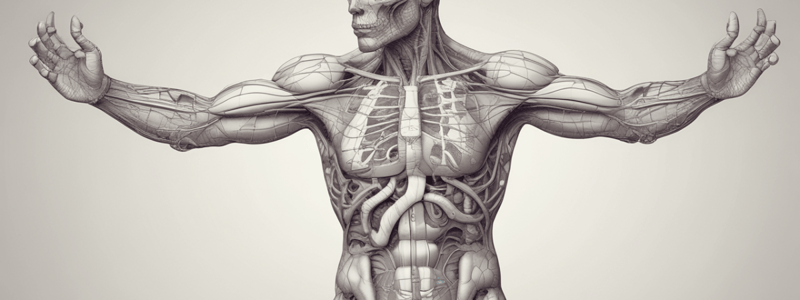Podcast
Questions and Answers
What is the primary function of the tunica media in blood vessels?
What is the primary function of the tunica media in blood vessels?
- To provide a barrier between the blood and the vessel wall
- To contain smooth muscle and elastic tissue (correct)
- To anchor the vessel to surrounding tissue
- To facilitate the exchange of oxygen and nutrients
Which type of artery is characterized by its ability to stretch without tearing in response to increased pressure?
Which type of artery is characterized by its ability to stretch without tearing in response to increased pressure?
- Muscular Arteries
- Elastic Arteries (correct)
- Capillaries
- Arterioles
What is the outermost layer of a blood vessel responsible for?
What is the outermost layer of a blood vessel responsible for?
- Regulating blood flow and pressure
- Anchoring the vessel to surrounding tissue (correct)
- Facilitating the exchange of oxygen and nutrients
- Providing a barrier between the blood and the vessel wall
Which of the following arteries is NOT an example of an elastic artery?
Which of the following arteries is NOT an example of an elastic artery?
What is the purpose of the elastic fibers in the tunica media of elastic arteries?
What is the purpose of the elastic fibers in the tunica media of elastic arteries?
Which of the following is a characteristic of arterioles?
Which of the following is a characteristic of arterioles?
What is the main function of Starling forces in the capillary bed?
What is the main function of Starling forces in the capillary bed?
What is the pressure-driven movement of fluid from the blood capillaries into the interstitial fluid?
What is the pressure-driven movement of fluid from the blood capillaries into the interstitial fluid?
What is the pressure that promotes reabsorption of fluid from the interstitial fluid back into the capillary?
What is the pressure that promotes reabsorption of fluid from the interstitial fluid back into the capillary?
What is the net filtration pressure at the arterial end of the capillary?
What is the net filtration pressure at the arterial end of the capillary?
What is the average percentage of fluid filtered that is reabsorbed?
What is the average percentage of fluid filtered that is reabsorbed?
What is the formula for blood flow?
What is the formula for blood flow?
What is the main factor that affects blood pressure?
What is the main factor that affects blood pressure?
What is the highest pressure in the arteries?
What is the highest pressure in the arteries?
What is the formula for mean arterial pressure?
What is the formula for mean arterial pressure?
What is the normal ratio of systolic:diastolic:pulse pressure?
What is the normal ratio of systolic:diastolic:pulse pressure?
What is the primary function of the muscular layer in muscular arteries?
What is the primary function of the muscular layer in muscular arteries?
What is the term for the union of two or more branches of arteries that supply the same tissue or region?
What is the term for the union of two or more branches of arteries that supply the same tissue or region?
Which type of capillaries are found in the kidneys and have larger holes?
Which type of capillaries are found in the kidneys and have larger holes?
What is the primary function of precapillary sphincters?
What is the primary function of precapillary sphincters?
What is the characteristic of venules that allows them to act as a reservoir of blood?
What is the characteristic of venules that allows them to act as a reservoir of blood?
What is the purpose of valves in veins?
What is the purpose of valves in veins?
Which type of arteries do not anastomose and blockage leads to necrosis and cell death?
Which type of arteries do not anastomose and blockage leads to necrosis and cell death?
What is the primary function of arterioles?
What is the primary function of arterioles?
What is the characteristic of capillaries that allows for the exchange of nutrients and wastes?
What is the characteristic of capillaries that allows for the exchange of nutrients and wastes?
Which type of capillaries are found in the liver and have a more extensive network?
Which type of capillaries are found in the liver and have a more extensive network?
What is the normal blood pressure in the aorta during systole?
What is the normal blood pressure in the aorta during systole?
What is the purpose of the skeletal muscle pump in venous return?
What is the purpose of the skeletal muscle pump in venous return?
What is the main function of baroreceptors in the neural regulation of blood pressure?
What is the main function of baroreceptors in the neural regulation of blood pressure?
What is the effect of epinephrine and norepinephrine on cardiac output?
What is the effect of epinephrine and norepinephrine on cardiac output?
What is the function of antidiuretic hormone (ADH) in the hormonal regulation of blood pressure?
What is the function of antidiuretic hormone (ADH) in the hormonal regulation of blood pressure?
What is the effect of atrial natriuretic peptide (ANP) on blood pressure?
What is the effect of atrial natriuretic peptide (ANP) on blood pressure?
How long does it take for a drop of blood to go from the right atrium and back?
How long does it take for a drop of blood to go from the right atrium and back?
How many miles does a person's blood travel in one day?
How many miles does a person's blood travel in one day?
How many times does the heart beat in a year?
How many times does the heart beat in a year?


